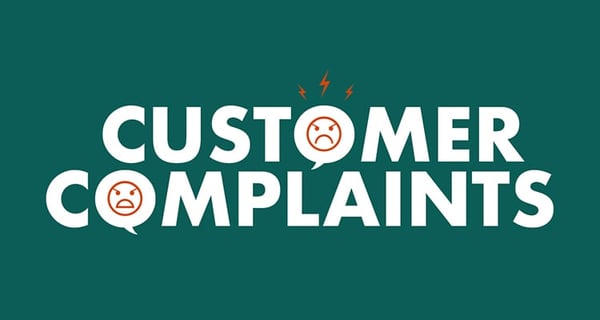Table Of Contents
When was the last time you provided good customer service?
No, scratch that. Good is mediocre.
When was the last time you provided GREAT customer service?
Most companies don't prioritize customer service.
Yet, Zappos built a billion dollar empire by delivering excellent customer service.
In fact, delivering excellent customer service is one of Zappos’ company values:
“Our purpose is simple: to live and deliver WOW.”
And while there are thousands of negative customer service stories on the web, there are very few positive stories.
Whether you provide customer service by phone, email, live chat or social media, we've gathered some of our favorite stories online and share our thoughts on what makes them so good.
What is good customer service?
How important is good customer service?
Customer service has an impact on both existing customers and potential customers.
Did you know that 68% of consumers would react by telling family and friends about a bad experience by posting it on a social network?
And almost 50% of customers claim they would switch to a new brand after just one bad experience!
And as each Facebook profile has an average of 338 friends , one negative experience can quickly reach thousands!
However, there is great value in ensuring you deliver positive customer service.
The value of exceptional customer service continues to rise, with current data from 2023 revealing that 1 in 3 customers would gladly pay up to 15% more across various industries, underlining the substantial ROI that outstanding customer service can deliver.
A 2024 survey found an impressive 95% of consumers identify excellent customer service as the key to their loyalty towards a brand, spotlighting the direct link between quality customer interactions and sustained business growth
Plus, 96% of consumers consider customer service to be a crucial factor when deciding whether to remain loyal to a particular brand.
Increased sales and customers is one of the benefits. But there’s more, too.
The benefits of good customer service
The worst thing you can do to a customer is ignore them if they try to contact you. Here’s 3 additional benefits of customer service.
Increases loyalty and satisfaction
Happy customers are less likely to stop doing business with you. Plus, if they’re loyal, they will spend more. By using customer service to help them, you can save costs on marketing, helping you reach profitability faster.
Improves word of mouth recommendations
Good customer service is good marketing.
If a customer is unhappy, they will tell their friends or complain on social media, resulting in a negative perception of your brand. However, if someone is happy with the service you provide, they can influence their network to visit, shop or buy from you.
Understand your customers better
What problems do your customers have issues with? What kind of feedback do they share with you? And how can you improve your product or service?
Without customer service, you’re just guessing. With customer service, you have the answers. Directly from the customers themselves.
How you communicate with customers differs from company to company.
Today, there’s no shortage of customer service channels.
Most popular customer service channels
Great customer service happens in all channels - email, social, SMS, chat and phone.
But regardless of which channel your customers use, they all want the same thing:
High quality support.
So, which channels should you be active in?
Here’s the 6 channels you need to know about.
- Phone: Customers still love to speak to someone - especially when it comes to urgent issues. While it’s nice to be digital, always make sure a customer can reach someone by phone.
- Messaging apps: A key communication channel for Gen Z, messaging apps (think Facebook Messenger) are a great way to handle customer service messages over an extended period of time as they are managed as an ongoing conversation.
- Social media: Your customers use social media. They also use it to express how they feel, so unlike a direct email to your support team, engaging with customers on social media requires you to be proactive. Find existing conversations and engage with your customers.
- Email: After phone support, email is the most-used customer service channel. The great thing about email is that it creates a digital record of correspondence - both for you and the customer. And with the right technology, you can automate, escalate and route emails within your organization to improve response times.
- Chat: Great for helping people directly on your website, live chat allows you to communicate with customers in real time. The great thing about live chat is that it can be used by sales reps for upselling, marketing departments for lead generation and customer service teams to handle questions from customers.
- Contact forms: Businesses with company websites can create contact pages meant for customers to submit inquiries, file grievances, or ask general questions with your support team.
So, now you know the benefits of customer service and the channels you can use to communicate with them, here’s 5 examples to inspire you to deliver better quality.
7 examples of great customer service
Here are seven ways to stand out from the crowd to help you deliver excellent customer service.
Let's get started!
Respond as quickly as possible
One of the biggest factors in good customer service is speed, especially when a client is requesting something that’s time sensitive.
Recent benchmarks from 2023 indicate an improvement, with the average email response time now at 10 hours among top retail companies.
However, industry leaders are setting new standards by aiming for response times of under 1 hour, highlighting the increasing importance of speed in customer service excellence.
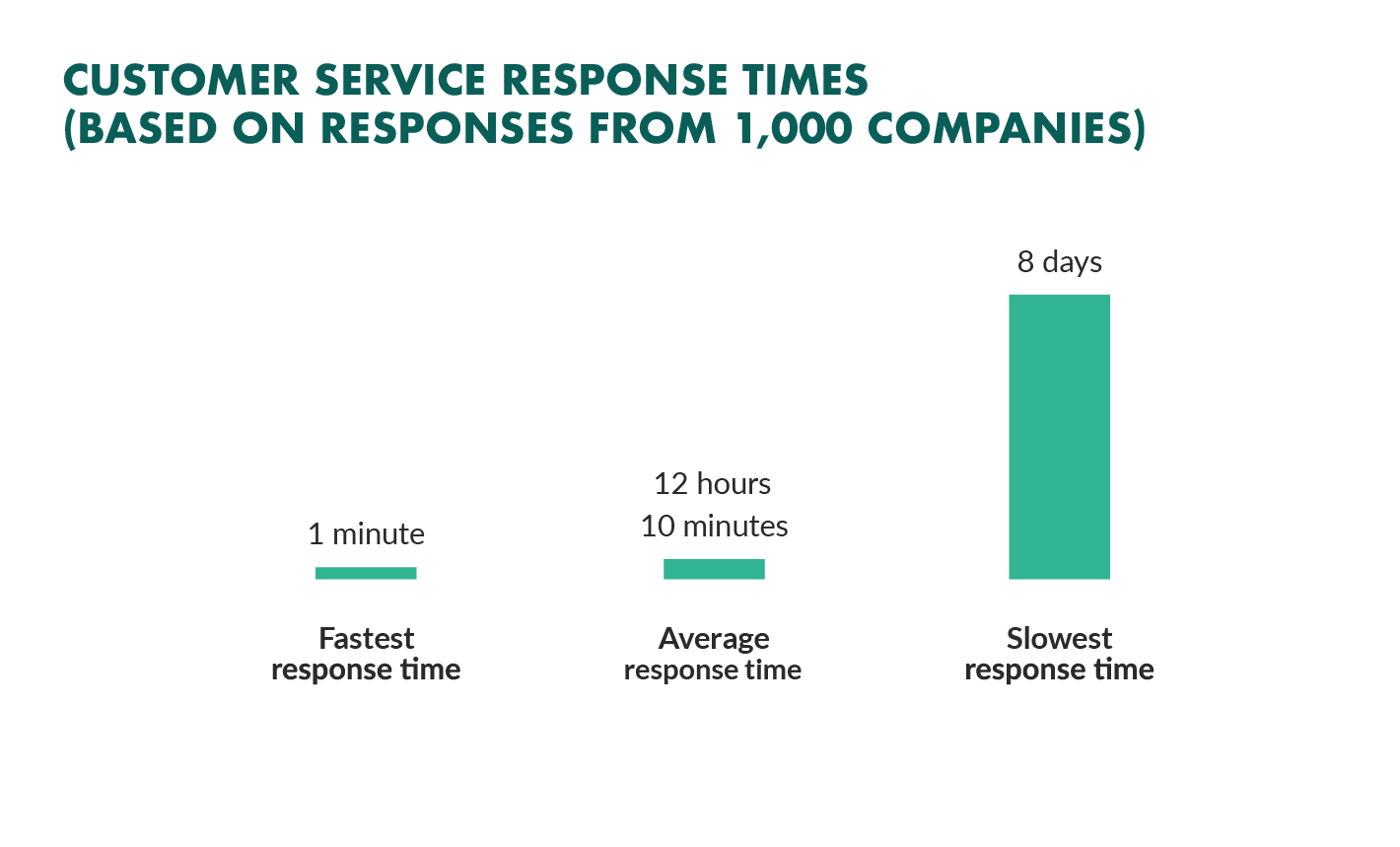
Meanwhile Frost reported that 41% of consumers surveyed listed being put on hold as their biggest frustration.
The key takeaway?
Don’t leave customers waiting.
A great example of this is when Lexus recalled a series of Lexus ES 350 sedans and asked car owners to visit a dealership to bring their cars in. Instead of having to sit in a waiting room watching their cars being worked on, their customers were given a brand new Lexus instead.
But what if you created an environment where customers wanted to be kept waiting? It sounds counterintuitive, I know.
Hear me out (thanks to Lena Bomko for sharing this on LinkedIn).
Richard Branson knows a thing or two about customer service.
In fact, a few years ago, Virgin Atlantic decided to conduct a psychological experiment to make customers WANT long response times.
No one wants to hear - “Your call is important to us” and then have to wait an hour. Instead of that message, Virgin experimented with the following:
“Hello, my name is Richard Branson.
I'm the owner of the airline. Now all operators are busy.
Let's proceed as follows:
After 18 seconds, if no one answers, you will receive a discount of £450.
I'm starting the countdown – 18, 17, 16, 15 ..."
Instead of the customer being annoyed at waiting for more than 30 seconds - the opposite effect happens. Now, they hope the operator doesn’t answer.
Did it work? We’ll never know - the results weren’t released publicly.
That is how you turn a negative customer service experience into a positive one.
The SuperOffice customer service team reduced response times from 5 hours to less than 1 hour in less than 6 months, without compromising on quality. How? By using SuperOffice Service.
Want to reduce your response times? Book a demo here.
Know your customers
Great interactions begin with knowing your customers wants and needs. Customers love personalization. Get to know your customers, remember their names and previous conversations. If needed, make a note of what was discussed previously so you can refer to it the next time you meet.
In January 2020, Starbucks launched their "Every name's a story" campaign focusing on improving relationships with their customers. The award winning campaign promotes inclusivity, recognition and acceptance at Starbucks stores across the world. The video, a focal point of the campaign, has generated more than 2.8 million views on YouTube.
Fix your mistakes
Not taking responsibility for your mistakes is a sure fire way to getting a bad reputation. Transparency is important in business and customer service is no different. Always strive for a high quality output as it shows you have a high level of standards.
An Amazon customer ordered a new PlayStation for his son for Christmas. When the shipping company delivered the parcel, the customer was away and had a neighbor sign for the package. The neighbor left the package outside the customer’s house and unfortunately, it soon disappeared. When the customer realized what had happened, he was left in complete shock!
Even though Amazon was not to blame for this mistake, they were quick to resolve this by not only sending a new PlayStation in time for Christmas, but did not charge for the extra shipping.
The Customer Success team at Amazon showed great empathy here towards the customer. Rather than sticking to their refund policy, they chose to do good. And that's what matters most.
Listen to your customers
Listening to your customers will not only result in an indebted and happy customer, it can also go a long way in terms of keeping yourself on their radar for future business.
A three year old named Lily Robinson wrote a letter to Sainsbury’s, a UK grocery store, asking why ‘tiger bread was called tiger bread and not giraffe bread?’. Lily was clearly onto something, as the bread really does look like a giraffe print!
In most cases, these types of suggestions are met with a simple "Thank you".
But, to Lily’s surprise, Chris King, the customer service manager of Sainsbury’s responded with “I think renaming it to giraffe bread is a brilliant idea!”. Several months later, the bread was renamed to giraffe bread.
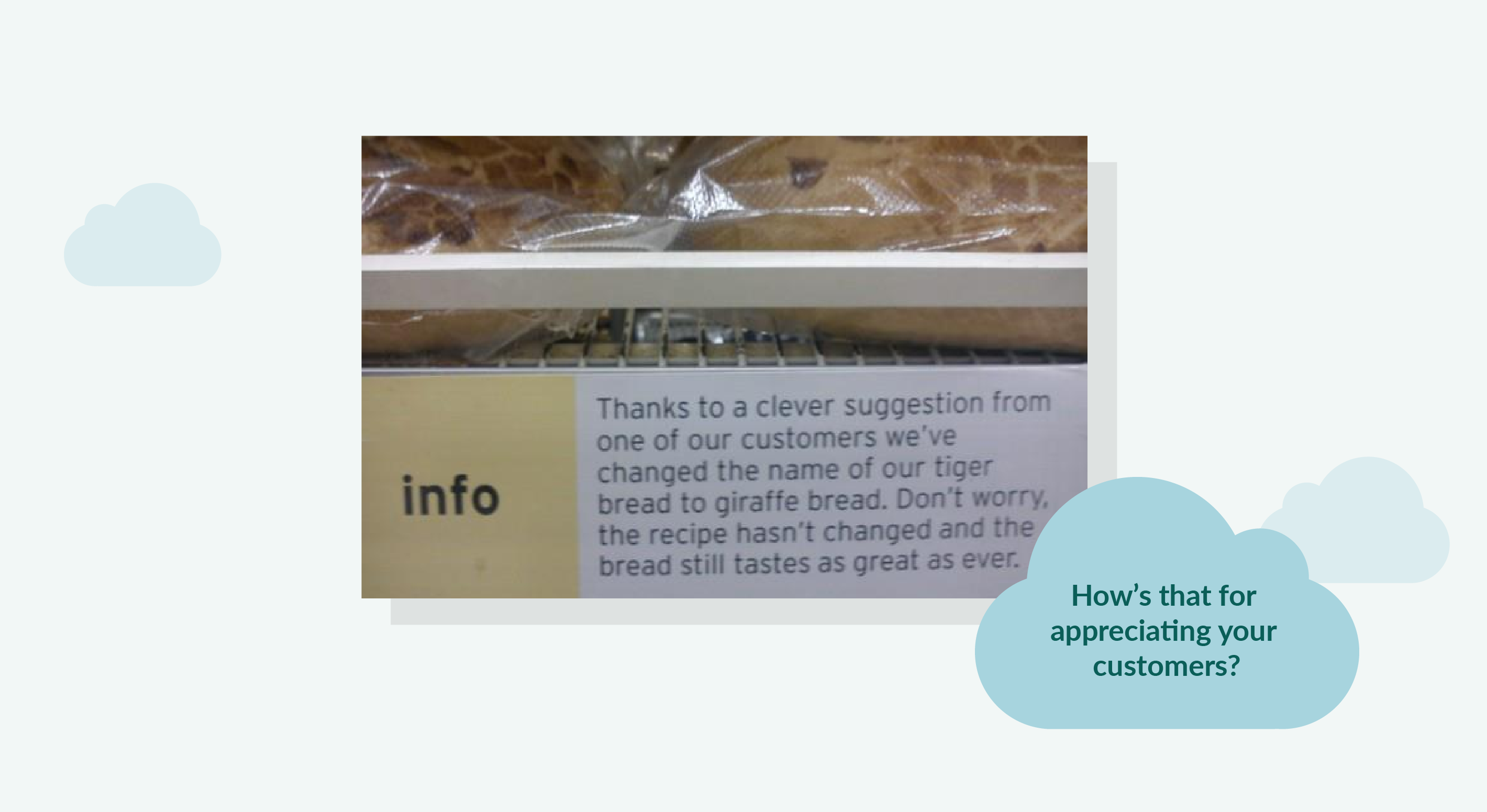
How's that for appreciating your customers?
As head of our customer service center, Stein Ove Sektnan couldn’t agree more with the value of listening to your customers. Here’s what he had to say on the topic.
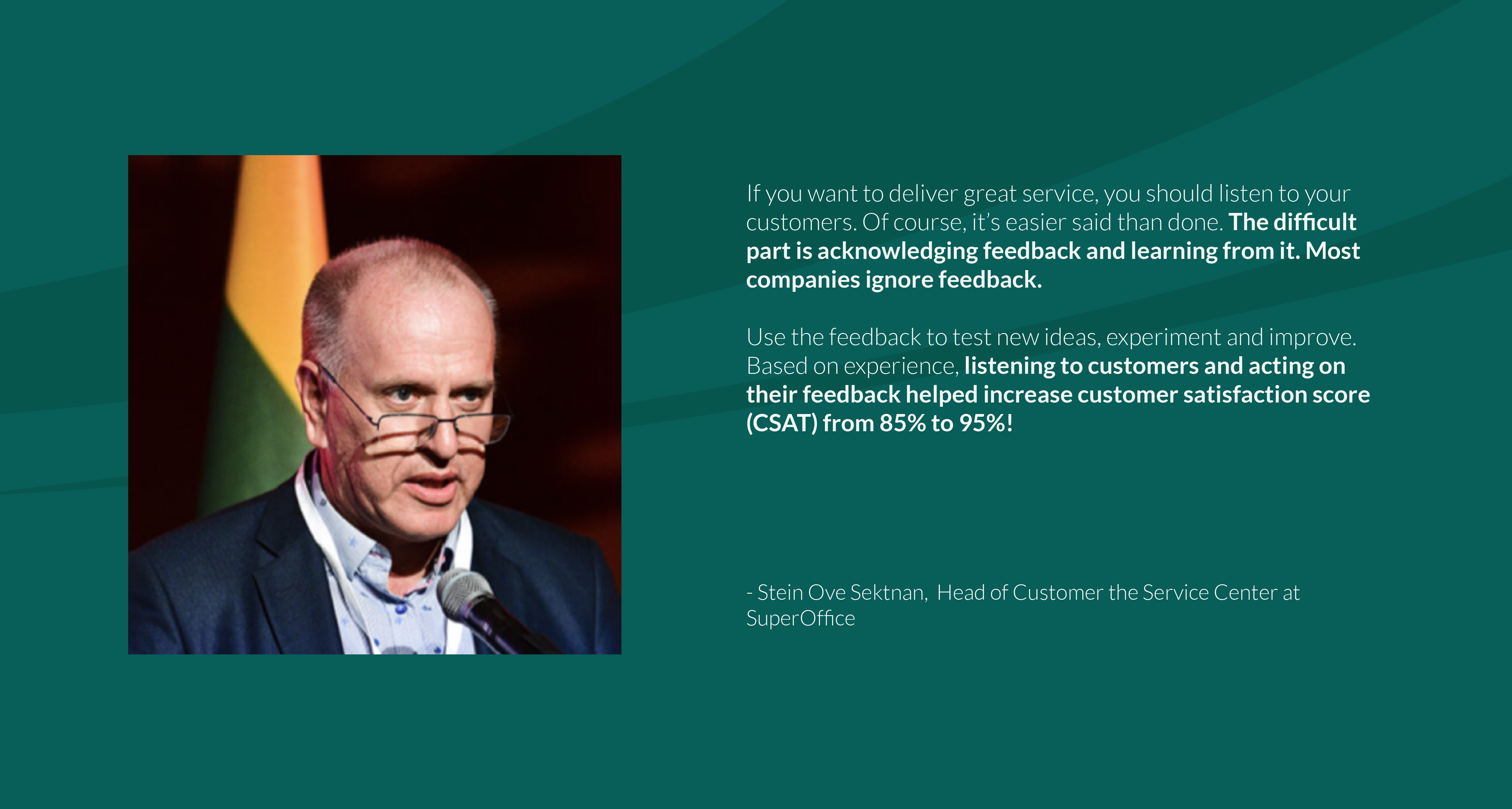
Think long term – A customer is for life
Think long term when dealing with customers. By keeping customers happy, they will be loyal and through word of mouth, will do the marketing for you. In fact, according to author Pete Blackshaw, a satisfied customer tells at least three friends (whereas an angry customer tells 3,000!)
Peter Shankman, author and business consultant, was ready to board a flight before tweeting “Hey, @Mortons – can you meet me at Newark airport with a porterhouse when I land in two hours? K, thanks. :)”.
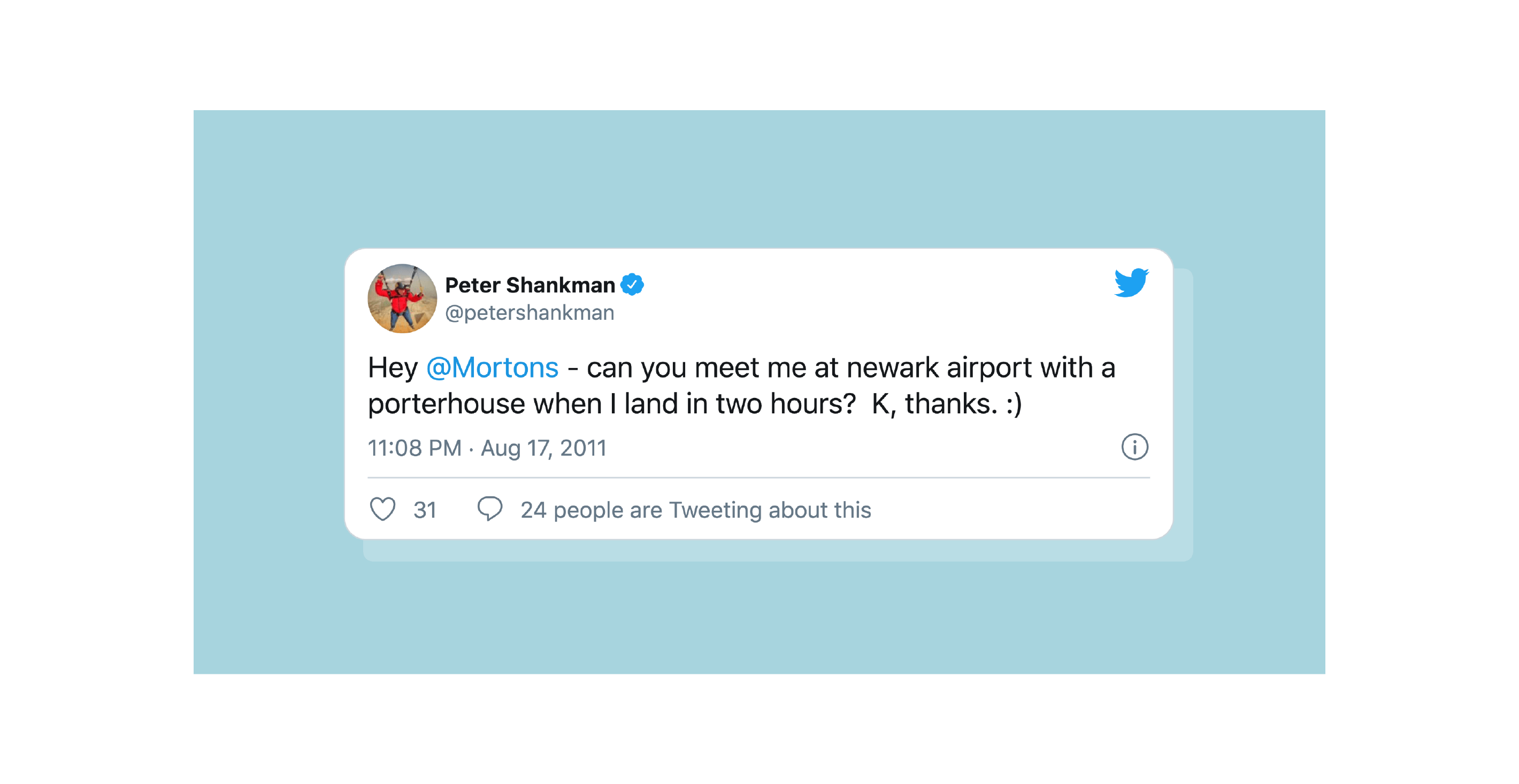
A fun attempt at humor, right?
Peter admitted he was joking. He never expected anything after he sent that Tweet...
But, as soon as Peter landed, a gentleman wearing a tuxedo was holding a bag that contained a porterhouse steak, shrimp, potatoes, napkins and silverware. Knowing that Peter was a regular customer and having tracked down his arrival details, Morton’s traveled more than 23 miles to deliver his food and with - one of the greatest customer service stories of all time.
Would you travel 23 miles to provide one of the most legendary stories on customer service?
I know I would.
Julija Ražanskienė, Support Manager at SuperOffice since 2016, knows all about balancing short-term support metrics with a genuine passion for building long-term relationships with customers.
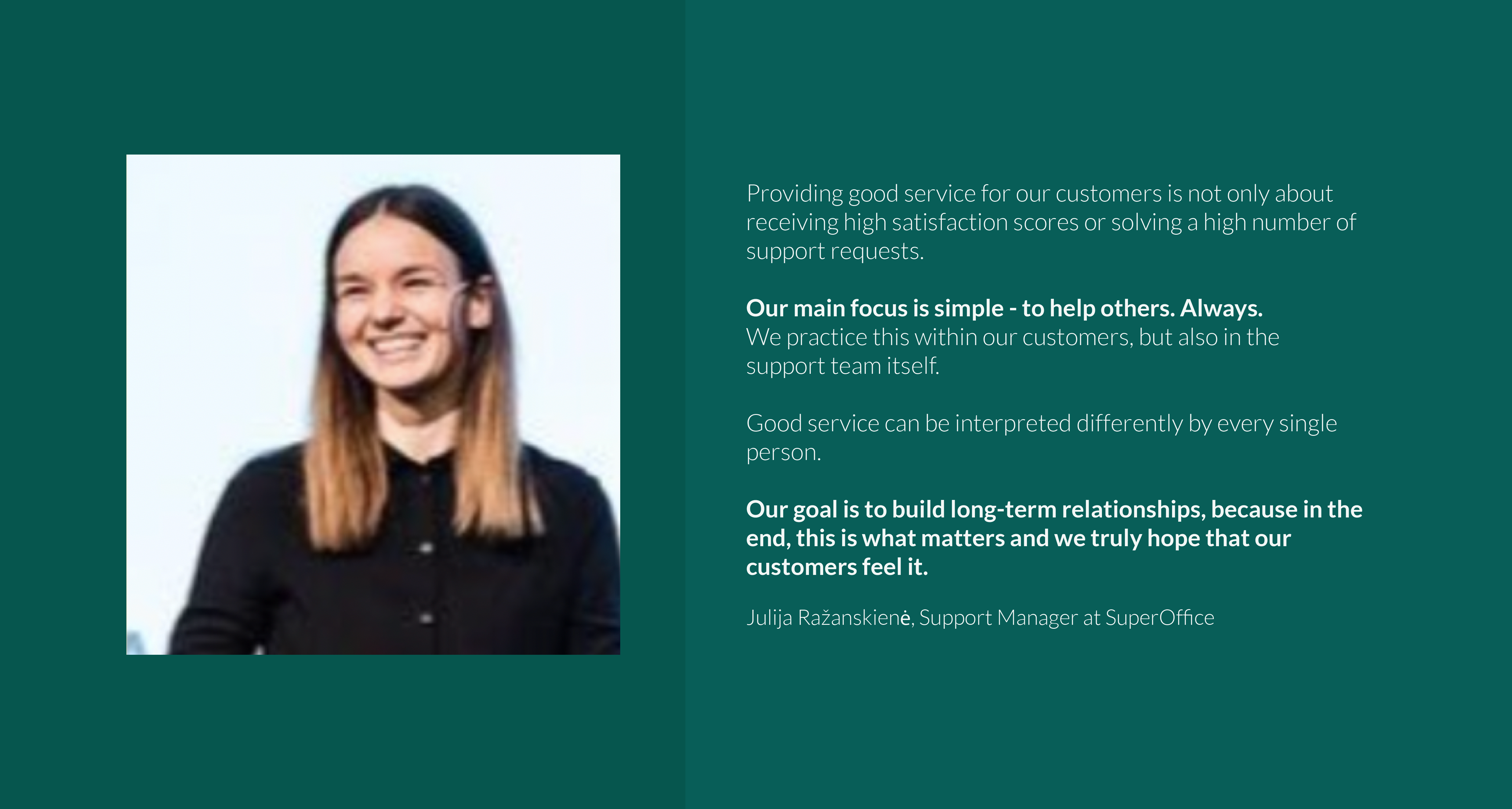
Personalize the experience
Giving customers personalized service is a great way to show them that you care about their business.
To make that happen, you need to understand what they like and what they’re interested in - plus what they need, so you can tailor your service specifically to them.
For example, if you have an online store, you can suggest products based on their previous purchases or what they've been looking at and searching for on the web.
And if you offer a service, you can customize your solutions to fit their unique requirements - that checks off all their boxes.
By doing this, not only are you showing your customers that you value them - you’re also showing them that you are willing to do whatever it takes to make them happy.
Empathize with your customers
When a customer has a complaint, they want to know that you're genuinely listening and that you actually care about their concerns. That's the main reason why empathy is so incredibly important in great customer service.
It means you’re putting yourself in their shoes and really understanding where they're coming from, and what they need help with, as if you were the one with the same problem.
You need to pay attention to their worries, say sorry for any mistakes, and work with them to find a solution that meets their needs and requirements.
By doing this, you're showing (not telling) your customers that you value their business and their interest in your company - and that you're committed to making things right.
Plus, by empathizing with them, you can learn more about their genuine interests, likes and dislikes, which will help you improve your service in the long run.
3 ways to improve customer service
If you want to improve relationships with your customers, start by making small changes to your customer service.
No matter how great your business is or how talented your team may be, customers will always remember the interactions they have with your company.
Here are a few customer service tips to deliver a better customer experience:
- Deliver contextual based support
- Innovate the customer journey
- Invest in human and automated service
Deliver context-based support
When customer service teams have a 360-degree view of a customer’s needs are better at finding opportunities to improve customer experience.
An overwhelming majority (76%) of consumers expect customer service reps to know their contact, product, and service information history.
Yet, according to Microsoft's report on the State of Global Customer Support, nearly half of respondents say agents almost never or only occasionally have the context they need to most effectively and efficiently solve their issue.
Customers feel frustrated whenever they have to repeat themselves or believe that customer service lacks the knowledge about their issue. By unifying customer information with a CRM, customer service reps gain the context and ability to resolve inquiries in a single interaction.
Get full context on every customer with SuperOffice Service. A seamless integration with SuperOffice CRM means you can access a customer's product and service history in seconds. Book a 30-minute demo and we’ll walk you through this exact process.
Innovate the customer journey
Customer experience has become the driving force that determines whether a customer will stay or abandon your business. However, the methods of delivering a memorable customer experience has changed over the years.
Back in 2013, Walker Information surveyed more than 300 customer experience professionals from large B2B companies to gain insights on future trends.
While email was the most common communication channel (77%) with customers, they predicted that online communities (68%), social media (63%), and corporate websites (61%) would come to dominate the way customers interact with companies.
Were they right? And how has the situation changed since?
Sprout Social’s report shows that 88% of marketers understand the importance of customer service appearing on social media with nearly 45% of consumers surveyed saying they have reached out to a company on social media.
While this is just one sample of the evolution of customer support, companies must innovate their customer journeys to adapt to today’s technology, platforms, and demands.
Invest in human and automated service channels
Losing loyal customers is detrimental to every company’s bottom line.
In CallMiner’s 2020 Churn Index Report, 43.3 million people are switching companies and 88.3 million are considering switching for reasons that could have been avoided. That’s more than $35.3 billion in lost revenue due to unplanned churn.
Companies that fail to invest in a combination of human and automated self-service channels are missing opportunities to create loyal, satisfied customers.
Automated self-service channels, such as a knowledge base, offer customers the ability to solve issues on their own.
However, if they can’t find the information that they need, that’s when human service channels, such as real time chat, serve to complement customer support and address issues quickly before frustrations escalate.
Conclusion
Working in a customer service department isn’t glamorous.
In most cases, service agents are the lowest paid people in your company, they work ridiculous hours (24/7) and have to deal with unhappy customers.
Yet customer service is the most important department you have.
(Maybe it’s time to give them a raise?).
Poor customer service can kill your brand overnight.
While great customer service can help you become a market leader - to the level that companies are now using customer service as a way to stand out against the competition. Are you ready to do the same?
Start delivering better customer service today!
Book a demo with a SuperOffice expert and we’ll show you how you can use automation in SuperOffice Service to respond faster, escalate urgent tickets and improve team efficiency.
Customers also ask:
What are the 3 most important things in customer service?
The 3 important qualities of customer service revolve around professionalism, patience, and having a “people-first” attitude. Customer service will vary from customer to customer, but as long as you're following these 3 qualities, you will be able to support them.
What makes a customer happy?
You can make your customers happy by aligning with their needs and making sure that your business is committed to helping them achieve their long-term goals. Any business that puts the customer first can make its customers happier.
Is it OK to disagree with a customer?
Yes, it's OK to disagree with a customer. Customers want to feel that you are listening to them, and when they know that you are, it has a calming effect on them - and it shows you are taking their problem seriously.
How can businesses effectively measure and track the success of their customer service strategies?
Businesses can measure the success of their customer service strategies using a variety of metrics. Key performance indicators (KPIs) like customer satisfaction scores (CSAT), Net Promoter Score (NPS), and first response time are commonly used.
Regular customer feedback surveys can provide direct insights into customer satisfaction. Additionally, monitoring social media and online reviews can offer real-time feedback. For a more comprehensive analysis, businesses can track the resolution time for customer issues and the rate of repeat contacts from customers.
What are some specific tools or technologies that can enhance customer service, especially in a digital or remote environment?
There are several technological tools that can significantly enhance customer service:
- Customer Relationship Management (CRM) Software: Helps in managing customer data and interactions, providing a unified view of the customer journey.
- Live Chat Tools: Enable real-time communication with customers on websites or apps.
- Chatbots and AI Assistants: Offer automated responses to common queries, improving response times and availability.
- Social Media Management Tools: Assist in tracking and responding to customer inquiries on social media platforms.
- Help Desk Software: Organizes customer support tickets and streamlines the resolution process.
- Analytics Tools: Provide insights into customer behavior and service efficiency.
How can mid-size companies with limited resources implement these customer service strategies effectively?
Mid-size companies can adopt the following approaches:
- Focus on Personalized Service: Leveraging the advantage of a smaller customer base to provide personalized interactions.
- Use Cost-Effective Tools: Opt for customer service tools that offer essential features.
- Empower Employees: Small teams can be cross-trained to handle multiple aspects of customer service.
- Leverage Social Media: Use social media platforms for customer engagement and support.
- Implement Feedback Loops: Regularly collect and act on customer feedback to continuously improve service quality.



